Graphics Reference
In-Depth Information
Proof.
The corollary follows from Theorems 7.4.1.10(1) and 7.4.1.14. See also Corol-
lary 7.4.2.23(3).
Theorem 7.4.1.10(3) showed that the fundamental group of a space is not neces-
sarily abelian. Is there any connection between it and the first homology group? After
all, in both cases we are dealing with one-dimensional “holes.” To answer that ques-
tion we describe a natural map from one to the other.
Note.
To simplify the discussion below we are pretending (as we earlier said we
would) that polyhedra have well-defined homology groups.
Let
X
be a connected polyhedron and let
x
0
Œ
X
. Define
(
)
Æ
()
mp
:
Xx
,
H
X
1
0
1
1
as follows: Let [a] Œp
1
(
X
,
x
0
), where a :(
I
,∂
I
) Æ (
X
,
x
0
). If
j :
IS
Æ
is the map
()
=
(
)
j
t
cos
2
p
t
,sin
2
p
t
,
then a induces a unique map b :
S
1
Æ
X
with the property that a(t) =b(j(t)). (b is the
unique map that makes the diagram
b
S
1
X
j
a
(I,∂I)
commutative.) Now b induces a map b
*
on homology groups. If i is a fixed (“stand-
ard”) generator of H
1
(
S
1
), then
[
()
=
()
Œ
()
ma
b
*
i
H
1
X
.
7.4.1.16. Theorem.
(1) The map m defines a homomorphism of groups called the
Hurewicz
homomorphism
.
(2) The map m sends p
1
(
X
,
x
0
) onto H
1
(
X
).
(3) The kernel of m is the commutator subgroup of p
1
(
X
,
x
0
).
Proof.
See [Cair68].
It follows from Theorem 7.4.1.16 that H
1
(
X
) is the abelianization of p
1
(
X
,
x
0
). The
advantage of the fundamental group of a space is that it gives somewhat more infor-
mation about the space than the first homology group. The disadvantage is that it is
more complicated to compute.



